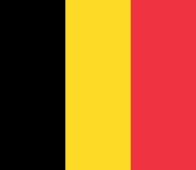Belgian flag
 |
|
| Use | National flag |
|---|---|
| Proportion | 13:15 |
| Adopted | January 23, 1831 |
| Design | A vertical tricolour of black, yellow, and red. |

Variant flag of Belgium
|
|
| Use |
civil ensign |
| Proportion | 2:3 or similar |

Variant flag of Belgium
|
|
| Use | State ensign |
| Proportion | 2:3 |
| Adopted | 1950 |
| Design | As above, with the central pale defaced by a lion rampant ensigned by a crown, both sable (black), the lion armed and langued gules (red). |

Variant flag of Belgium
|
|
| Use | Naval ensign |
| Proportion | 2:3 |
| Adopted | 23 February 1950 |
| Design | A yellow saltire on a white field, bordered above and below in red and to the left and right in black, charged on the top with a crown above crossed cannons and on the bottom by a fouled anchor. |
The national flag of Belgium (Dutch: Vlag van België, French: Drapeau de la Belgique, German: Flagge Belgiens) is a tricolour of three bands of black, yellow, and red. The colours were taken from the coat of arms of the Duchy of Brabant, and the vertical design may be based on the flag of France. When flown, the black band is nearest the pole (at the hoist side). It has the unusual proportions of 13:15
After the death of Charlemagne, the present-day territory of Belgium (except the County of Flanders) became part of Lotharingia, which had a flag of two horizontal red stripes separated by a white stripe. The territory then passed into Spanish hands, and after the coronation of Charles V, Holy Roman Emperor yellow and red, the colours of Spain, were added. From the 16th century to the end of the 18th century, the colours of what is now Belgium were red, white and yellow. Occasionally the red cross of Burgundy was placed on the white section of the flag.
During the period of Austrian rule, a number of different flags were tried, until the Austrian Emperor imposed the Austrian flag. The population of Brussels was opposed to this, and following the example of France, red, yellow and black cockades began to appear; those being the colours of Brabant. The colours thus correspond to the red lion of Hainaut, Limburg and Luxembourg, the yellow lion of Brabant, and the black lion of Flanders and Namur.
...
Wikipedia
